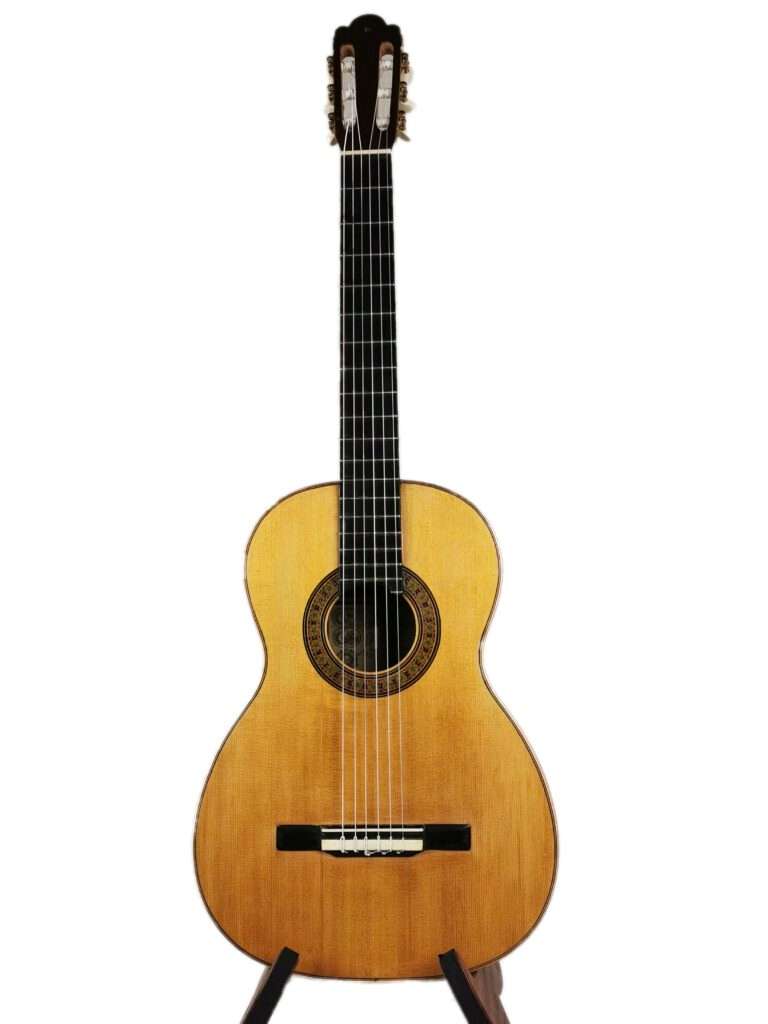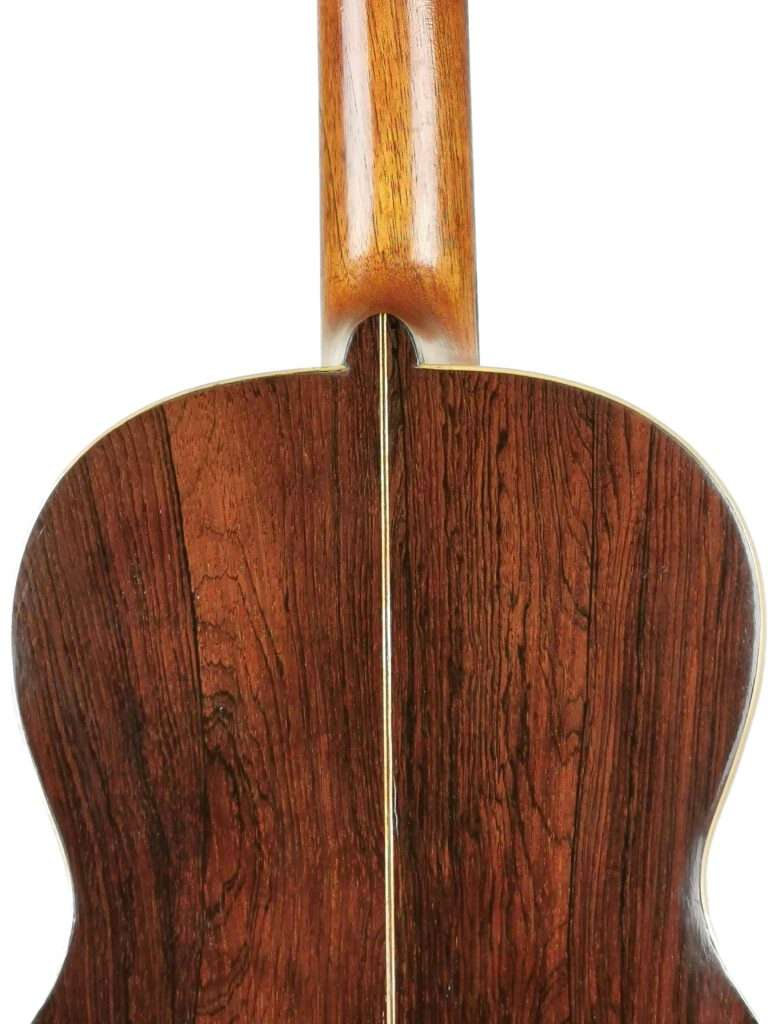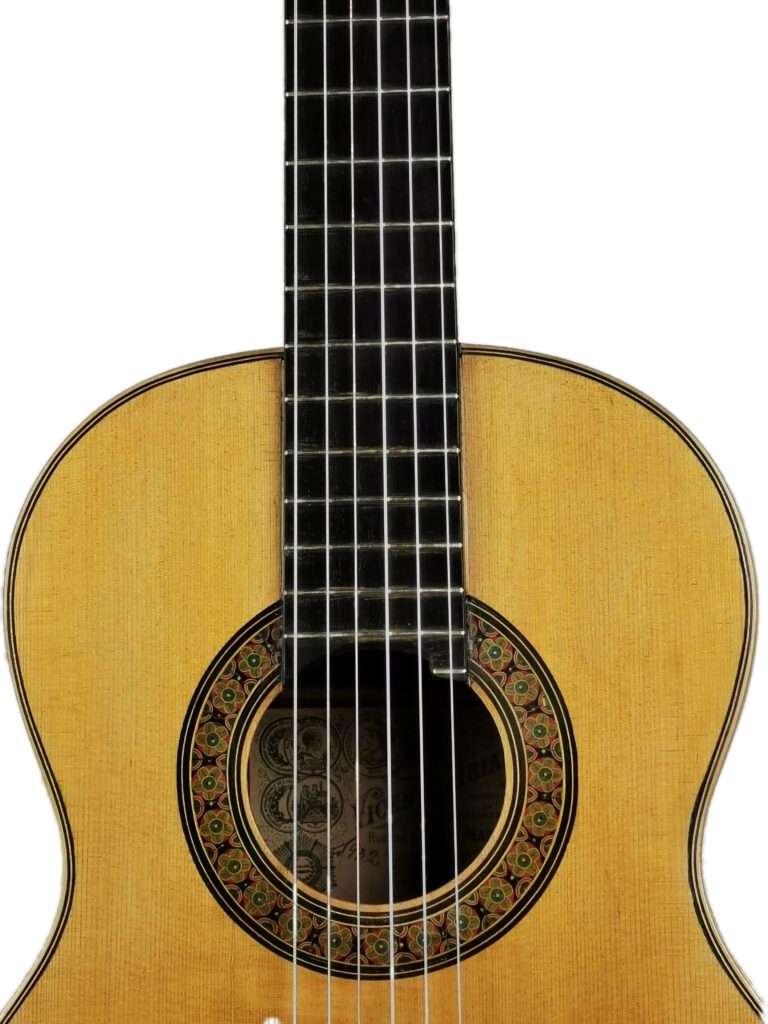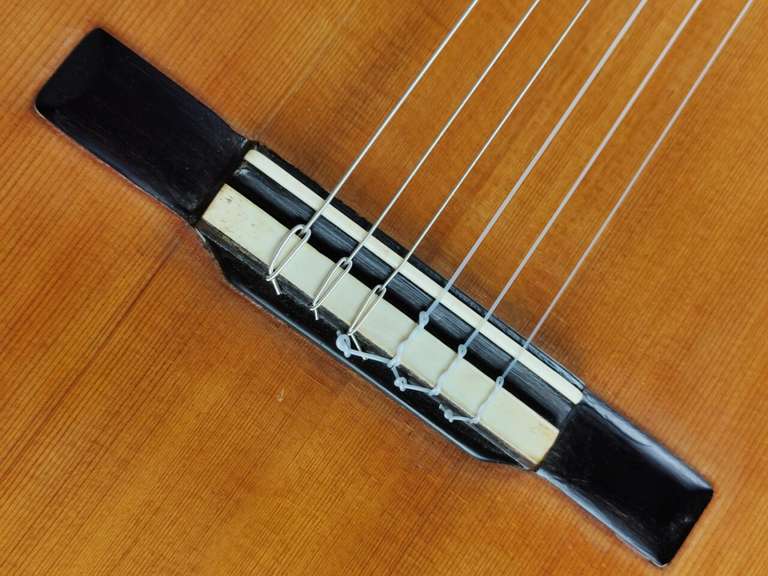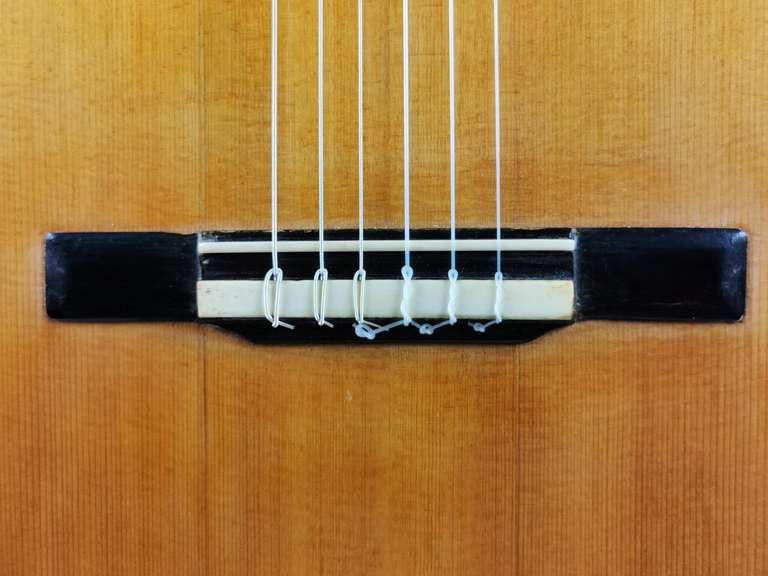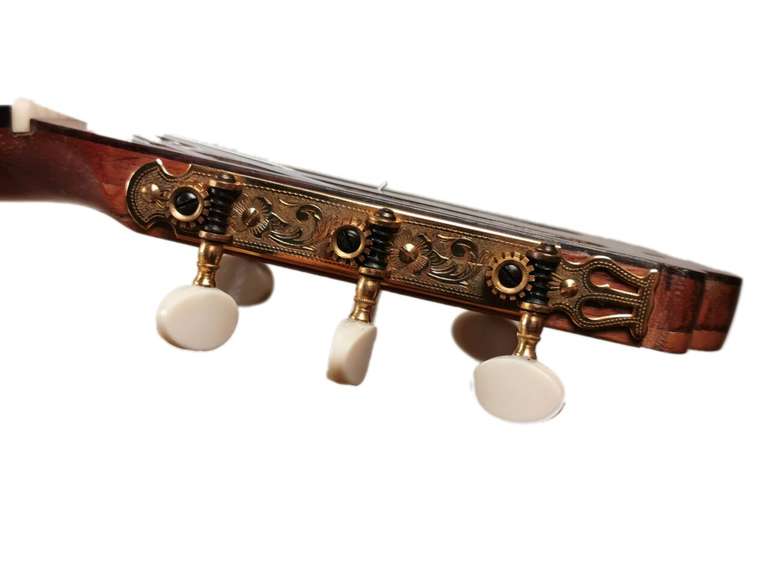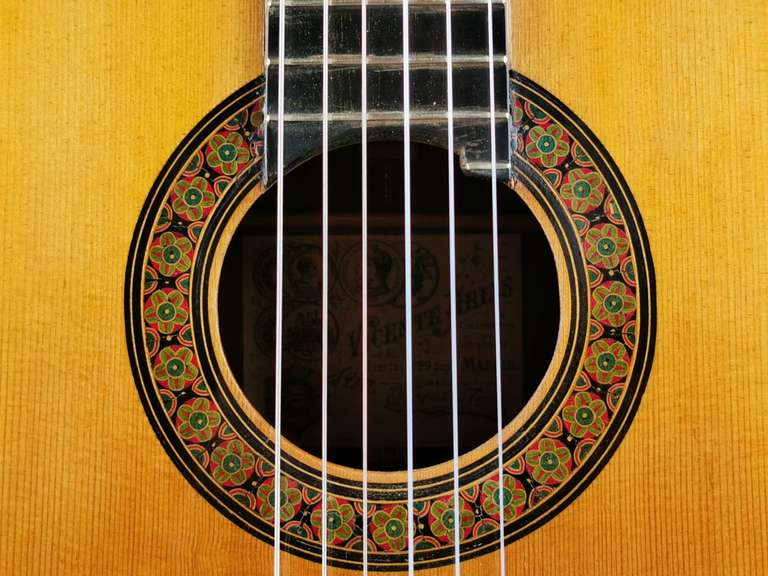Vicente Arias 1902
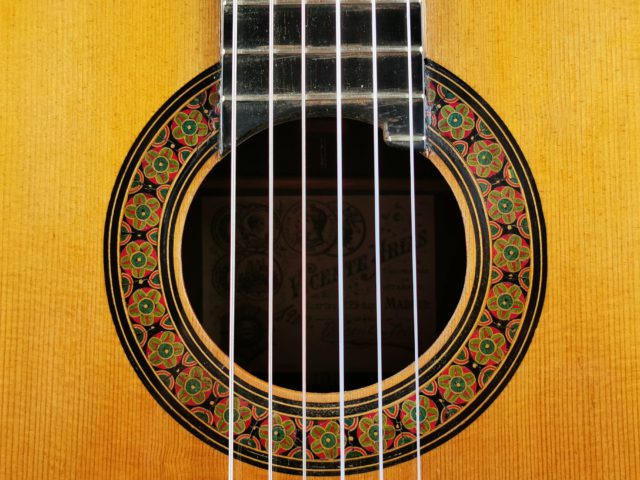
The guitar maker
Vicente Arias (1833 - 1914)
The first reference to the existence of Vicente Arias was provided by the newspaper El Pueblo Manchego (January 1914); there appeared the information of the death in Madrid of this great guitar maker (without indicating the exact date), making a very brief account of his life and work but without providing significant data.

Photo published in Vida Manchega, nº 95, on Thursday 29-1-1914
Vicente Arias was born in Alcázar de San Juan, on October 27, 1833. He was the son of Juan Arias, who is also known to be a miller, and Bernabea Castellanos. There is a big gap from his childhood and early youth years, but the truth is that we found him in 1851 -when he was only 18 years old- already living with his parents in the Plazuela de Dominicas in Ciudad Real, perhaps as an advanced apprentice in a cabinetmaker's workshop.
Emilio Puyol mentions that, around 1878-1879, a time when Vicente Arias had already acquired fame as a guitar maker and was still living in Ciudad Real, the well-known guitarist and composer Francisco Tárrega commissioned Arias with a guitar, but with the special circumstance that it was a little smaller than the model and size that had been established as the norm until then, with the intention that it could be better adapted to its physical and artistic characteristics. The success obtained in its construction must have been a lot - by adequately combining size, quality of materials and depth of the resonance box - and such a good result in the sound that, from now on, it seems that all or almost all of them would be manufactured in that a little smaller size. What apparently created school.
In 1889 there are data to the effect that he was still living in Ciudad Real and that he continued to have the business on Paloma Street and paid 40 pesetas. annual contribution. The following year, he rejected the manufacture of three guitars that an Englishman had requested, claiming that he had received a blow on the first day of Carnival on his left hand and it was dislocated, which prevented him from working.
As his fame is constantly increasing, in the years 1898 and 1900 his name began to appear in the commercial guides or Bailly-Bailliere Trade Yearbooks, as a manufacturer of guitars, and he still continued in Ciudad Real, and in Paloma Street. Years later it would continue to appear in those yearbooks, only already residing in Madrid.
It is between 1900 and 1903 when he had to make the decision to move to Madrid. The vast majority of its products were sold in the capital of the kingdom. Due to the form of transport (which was by means of some type of animal traction vehicle) and the problems of all kinds that arose in those long days (with the roads of the time) it is not unreasonable to think that for such powerful and commercial reasons , decided to move the industry to Madrid to be closer to its clientele.
Surely with that intention he installed the workshop on Calle Santa Isabel, 20, and his home address on Calle del Álamo, 3, where he lived until his death, on January 19, 1914 . In new information provided by Mr. Romanillos, it seems that between the years 1875 and 1880, he was first married to Ceferina Flores and Sánchez, and after being widowed, he appeared again around 1910 married to Josefa Puertas de Robles, a native of Lanjarón ( Granada), marriage that had no descendants.
Connoisseurs easily distinguish his guitars because they have the work of the marquetry rosette, being very showy and complicated. In some cases, it is composed of a mosaic making interlaced figures of different colors, and sometimes with two black fillets making waves that result in a difficult and beautiful work highly valued and sought after by connoisseurs. That is why Vicente Arias Castellanos' guitars are among the most recognized and valued by luthiers and collectors around the world, in addition to their painstaking work, their extraordinary sound, and are easily distinguished by the unique beauty of their rosettes already commented. All these reasons make the guitars built by Vicente Arias that still exist, reach truly astronomical prices.
Of the excellent quality of its products, says the Dictionary of Spanish and Hispano-American Music, -data provided by the Music Teacher, Antonio Vallejo-, that his instruments were mostly made, in a format smaller than the guitar. current, being one of the most notable built in the nineteenth and early twentieth centuries ". The aforementioned Encyclopedia continues, that "he was an innovator, since he was the one who began to reinforce the soundboard with four, six and even eleven radial fan-shaped rods, which at that time was one of the most audacious construction procedures ".
Due to the exceptional quality of his work, he won important distinctions, numerous medals, such as the one obtained at the Universal Exhibition in Barcelona in 1888, and even international awards, such as the one obtained at the Universal Exhibition in Paris.
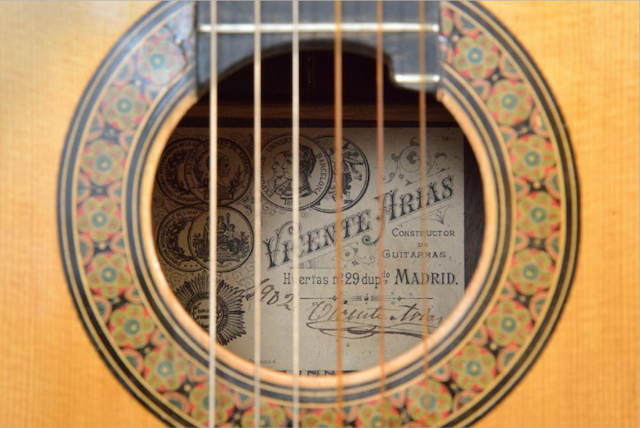
From the article published in guitarra.artepulsado.com by Federico Valero
Description
Guitars of Vicente Arias are not common with perhaps 65-70 known to exist today. They were, like this one, quite small in body size and almost every one seems to be different in terms of decorative detail. Some were very plain and simple and others highly-decorated. They do also vary in body size and plantilla shape, though rarely the size of the modern day guitar. In most cases, they have a very pleasing and often deep sound.
The air resonance of this guitar is around F giving the bass a full, deep character. The middle and treble are quite sweet and rounded.
The floral rosette is one of Arias's most beautiful; he produced some outstandingly beautiful patterns.
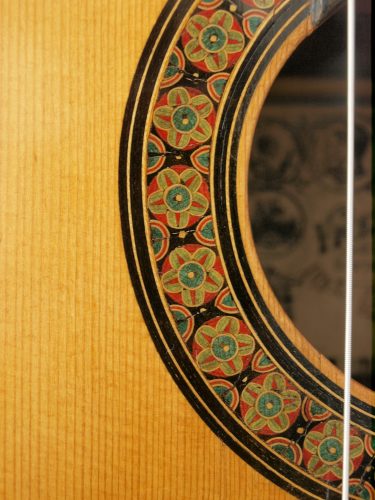
The purfling is quite simple and with maple (probably) bindings.

The bridge is very dark and could be ebony, with bone tie-block capping.
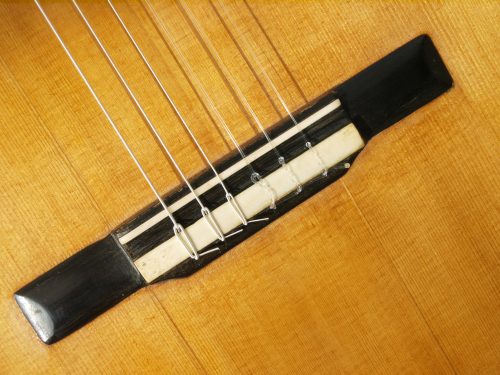
Condition
This guitar is more than 120 years old and for that time is in very good condition.
The rosewood sides appear to be in perfect condition with no repairs or visible cracks.
The back has some short, cleated cracks down at the bottom and edge. There is no continuous centre joint strip, but cleats at regular intervals. There is some small separation in some places - and possibly when made as there is a little glued paper underneath the bottom of the label.
The front has two long cracks (10 cm) that have been cleated a long time ago - and a smaller one to the treble side that has been traditionally fabric-patched.
| Origin: | Spain Madrid |
| Scale: | 649 with 18 frets (plus 19th for the 1st string) on an ebony fingerboard. |
| Top: | European Spruce - a good quarter-sawn top with a lot of silky medullary ray |
| Back & Sides: | Brazilian rosewood |
| Tuners: | Fustero with engraved brass side-plates and bone buttons. The head was thickened at the back a long time ago by Arcangel Fernandez, to be able to fit more modern tuners |
| Air resonance: | F |
| Weight: | 1126 grams |
| Body length: | 460 |
| Top bout: | 248 wide & 88 deep |
| Waist: | 207 wide & 88.5 deep |
| Bottom bout: | 338 wide & 90.5 deep |
| Neck Width: | 50.3 at the nut with 43.5 string spacing |

